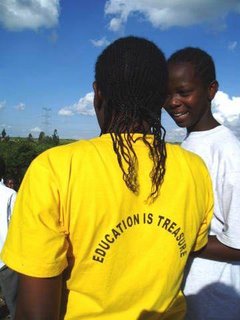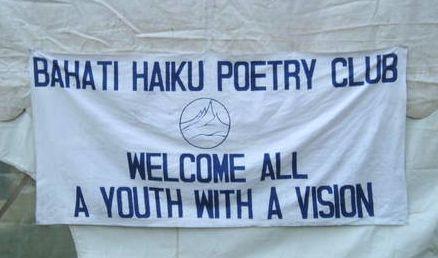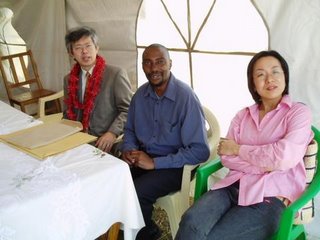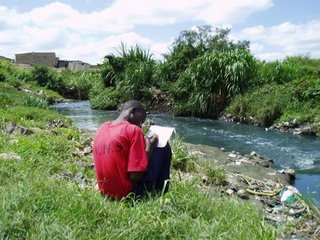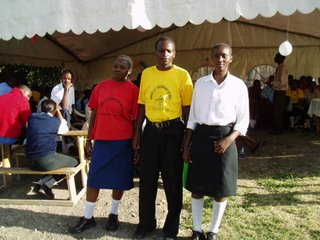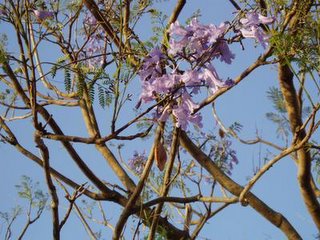:::::::::::::::::::::::::::::::::::::::::::::::::::::::::::::::::::::::::::::::::::::::::::::::::::::
Jiko (brazier) and makaa (charcoal)
***** Location: Kenya
***** Season: Cool dry season
***** Category: Humanity
*****************************
Explanation
The Kenyan jiko (brazier) is used all year round, in most parts of Kenya, for cooking meals of all types and sizes. It is heated with charcoal, which itself is also available all year round.
In the cool dry season, however, the jiko obtains an additional quality as a kigo -- it warms the cold house, even while it is being used for cooking. And when it cools off again after the meal has been prepared, the family gather round and enjoy the heat from it for another while.
The more luxurious Kenyan hotels and restaurants provide jikos for their guests in the evening on the outdoor terraces, so as to provide some heat against the chill at this time of year. The jiko as a heater has the quality of a fireplace, in that the heat is concentrated, and one can approach to warm one’s hands or feet -- but it also needs careful supervision, in case a child strays too near and gets burnt.

Charcoal embers glowing in a jiko
Photo © Isabelle Prondzynski
Kenyan charcoal is prepared in particular regions and brought to towns and cities, where it is sold in containers of various sizes :

Charcoal seller in Kibera, Nairobi
© PHOTO : Ina’s Pics
Charcoal is particularly popular in rural regions and urban slums, where there is no electricity and hence, there are no electric cookers. It is also popular for jikos in general, as these can be moved anywhere and are often used, even by the wealthiest people, when there are festive meals to prepare, as these may require many stoves for the various dishes.
Text © Isabelle Prondzynski
:::::::::::::::::::::::::::::::::::::::::::::::::::::::::::::::::::::::::::::::::::::::::::::::::::::
Cooking a special meal on a large jiko
Photo © Isabelle Prondzynski
Very informative video here :
http://www.youtube.com/watch?v=92P6P4Uyq1o
France24-EN report, October 2007
More links here :
http://www.solutions-site.org/kids/stories/KScat2_sol60.htm
http://ces.iisc.ernet.in/energy/paper/tech101/jikostove.html
http://www.flickr.com/photos/aidg/533788023/
*****************************
Worldwide use
India
I have come across very similar braziers in very similar climates in the evenings of India too, where hotel guests sitting on a terrace were provided with this kind of mobile heat.
Haiku :
This is how I remember ironing shirts in India, with an iron piece heated by charcoal fire ...
black-out again !
the ironing wallah grabs
for the charcoals
~ Gabi Greve
:::::::::::::::::::::::::::::::::::::::::::::::::::::::::::::::::::::::::::::::::::::::::::::::::::::::
Japan
. tadon 炭団 (たどん/ tandon たんどん ) charcoal briquette .
sumiuri, sumi-uri 炭売(すみうり)charcoal vendor, charcoal seller
and many more charcoal KIGO
*****************************
Things found on the way
Charcoal is used by the maize roasters along the roadsides of Kenyan towns and cities, such as this one :
Photo © Isabelle Prondzynski
Charcoal irons are common in Kenya too, wherever there is no electricity.
*****************************
HAIKU
charcoal business --
the day’s supplies arrive
by bike
~ Isabelle Prondzynski
xxxxxxxxxxxxxxxxxxxxxxxxxxxxx
my grandmother
spreading her hands over a jiko --
drizzly morning
my sister warming
a cold chick around a jiko --
drizzly evening
my father
roasting yams on a jiko --
dewy morning
~Esther Muthoni
neighbours waiting
for the wind to blow the jiko --
smokey room
traffic jam
caused by the charcoal lorry --
tired driver
family members
sitting around the jiko --
showery evening
charcoal seller
with a blackened face --
customers queue
~Peter Nguribu
clouds gathering,
the artisan struggles to finish the jiko --
imminent drizzle
~Patricia Nduta
Saturday evening
grandmother cooking githeri on a jiko --
red hot charcoal
Monday morning,
drying my uniforms on a jiko --
red hot charcoal
warming myself
around the jiko-
cold morning
~Onesmus Kyalo
my uncle
sits beside the hot jiko --
roasting meat
~Anne Wairimu
my mother
warming herself by the jiko --
drizzling morning
~Joseph Kilunda
cold night
crickets crying in fear --
charcoal crackling down
~Beryl Achieng
kids play around
a quickly burning jiko --
chilly morning
~ Judy
adding charcoal
to prepare dinner --
cold evening
~ Caroline Wanjiku
Cooking chapatis on a jiko
Photo © Isabelle Prondzynski
heating with jiko --
a busy man selling
roasted maize
jua kali artisan
modelling an iron sheet --
a young jiko
~ Martin Kamau
a charcoal iron
as clothes silently relax --
cold evening
~ James Bundi
grandmother shivering --
our lit up jiko
warms the room
~ Beryl Achieng'
rainy afternoon
mother in the kitchen
the jiko promises heat
~ Anne Wairimu
long queues
people demanding charcoal --
early risers
~ Solomon Kilelu
May evening --
my younger brother
beside the jiko
~ Jedida Nduku
an artisan
carefully mending a jiko --
cold afternoon
~ Peter Nguribu
grandmother
beside a rusty jiko --
chilly morning
~John Mwangi
my uncle
sneezing and wiping eyes --
the jiko smoke
~ Catherine Njeri Maina
:::::::::::::::::::::::::::::::::::::::::::::::::::::::::::::::::::::::::::::::::::::::::::::::::::::
in the grandfather’s hut
kettle on top of the jiko --
chilly morning
around charcoal burner
grandfather meets grandchildren --
story time
~ Maurice Opondo
much cold --
jiko lit with charcoal
warms people up
~ aineah otieno
chattering teeth
a chill breeze blows --
jiko the only saviour
~ shamim mbone
chilly morning
red hot charcoal in a jiko
breakfast session
cold evening --
family around the jiko
talking together
~ ayoma david
women in a queue
waiting to be served --
demand for charcoal
dizzy kids
around the jiko --
drops of rain on the dishes
~ hussein haji
around the jiko
grandmum gives stories --
cure for the cold
~ Ann Wanjiru
red hot charcoal
boiling coffee on it --
chilly morning
~ Duncan Omoto
:::::::::::::::::::::::::::::::::::::::::::::::::::::::::::::::::::::::::::::::
chilly June --
my little cat seats near
the jiko door
~ Kelvin Mukoselo
wind blows --
children point their
fingers around a jiko
children moving
around a jiko ---
enjoy legend stories
~ siboko yamame
late evening --
mummy lights a jiko
to cook ugali
~ Gladys Kathini
starlit night --
staring at the crescent moon
as I light the jiko
around the jiko
children talk and sing --
cold night
~ David Caleb Mutua
xxxxxxxxxxxxxxxxxxxxxxxxxxxxx
Charcoal vendor at a local market
Photo © Isabelle Prondzynski
cold season again
charcoal in demand --
dealers busy
four paraded jikos
outside a Soweto hotel
slowly burning up
a young man watches
charcoals passing on fire
from one to the other
early in the morning
mother lights a jiko --
smoke chokes her
~ Anthony Njoroge Irungu
*****************************
Related words
***** Slum fires
(Swahili : moto (singular) mioto (plural))
***** Kotatsu, heated table Japan
:::::::::::::::::::::::::::::::::::::::::::::::::::::::::::::::::::::::::::::::::::::::::::::::::::::
Back to the Worldkigo Index
:::::::::::::::::::::::::::::::::::::::::::::::::::::::::::::::::::::::::::::::::::::::::::::::::::::







